
ASUS ZenBook Duo 14 UX482 Review – Powerful Dual Display Delight
We previously unboxed the ASUS ZenBook Duo 14 UX482 dual screened ultraportable and looked at what freebies they bundled with the laptop as well as the hardware it has running under the hood.
This time around, check out our full-on ASUS ZenBook Duo 14 UX482 review below where we’ll put it through its paces and see how it handles under actual field conditions.
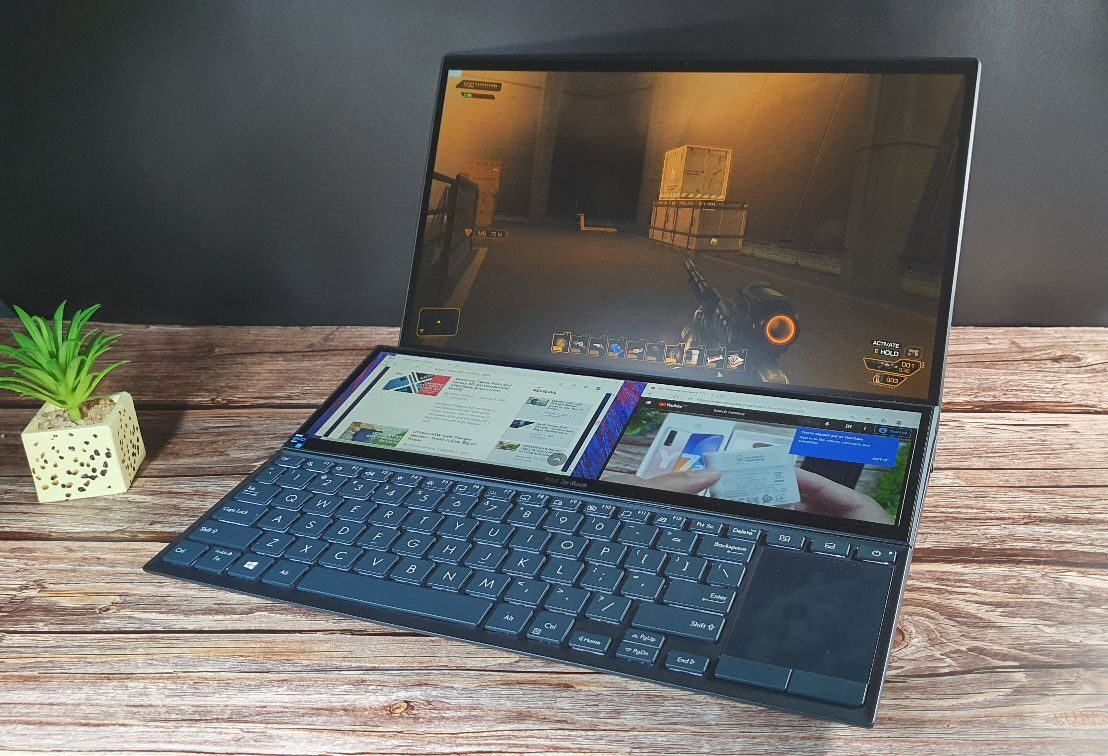
Malaysia ZenBook Duo 14 UX482 Differences
Table of Contents
One important thing to note with our ZenBook Duo 14 UX482 review sample is that it isn’t the exact version available in Malaysia.
While it adheres to the global specifications for the most part, it has three important differences that would impact on performance and benchmarks to some degree.
Another thing to note is that for Malaysia, ASUS is only bringing in two variants with the following specifications side by side with our review sample specifications:
| Details | ASUS ZenBook Duo 14 UX482 (Review sample) | ASUS ZenBook Duo 14 UX482 (Malaysia) |
| Price | Not available | Intel Core i7 2.8GHz w/16GB RAM (RM6,499) Intel Core i5 2.4GHz w/ 8GB RAM (RM5,499) |
| Display | Main Display: 14” (16:9) LED-backlit FHD (1920 x 1080) 60 Hz touchscreen 93% screen-to-body ratio PANTONE® Validated ,100% sRGB gamut Anti-glare panel IPS-level wide-view technology 4096-pressure level stylus support ScreenPad™ Plus: 12.6” FHD touch display 178˚ wide-view technology | Main Display: 14” (16:9) LED-backlit FHD (1920 x 1080) 60 Hz touchscreen 93% screen-to-body ratio PANTONE® Validated ,100% sRGB gamut Anti-glare panel IPS-level wide-view technology 4096-pressure level stylus support ScreenPad™ Plus: 12.6” FHD touch display 178˚ wide-view technology |
| Processor | Intel® Core™ i7-1165G7 | Intel® Core™ i7-1165G7 Intel or Core™ i5-1135G7 |
| Operating System | Windows 10 Home | Windows 10 Home |
| Graphics | Integrated Intel® Iris Xe Graphics | NVIDIA® GeForce® MX450, with 2 GB GDDR6 VRAM Integrated Intel® Iris Xe Graphics |
| Memory | 32GB DDR4 4x 4,266MHz | 16GB DDR4 4x 4,266MHz (i7 version) / 8GB DDR4 4x 4,266MHz (i5 version) |
| Storage | 1 TB M.2 NVMe™ PCIe® 3.0 Performance SSD | 512GB M.2 NVMe™ PCIe® 3.0 Performance SSD |
| Connectivity | Intel® Wi-Fi 6 (802.11ax) Bluetooth® 5.0 | Intel® Wi-Fi 6 (802.11ax) Bluetooth® 5.0 |
| Cameras | IR webcam with Windows Hello support | IR webcam with Windows Hello support |
| Interfaces | 2 x Thunderbolt™ 3 USB-C® (up to 40 Gbps) 1 x USB 3.1 Gen 2 Type-A (up to 10 Gbps) 1 x HDMI 2.1 1 x Audio combo jack | 2 x Thunderbolt™ 4 USB-C® (up to 40 Gbps) 1 x USB 3.2 Gen 1 Type-A (up to 5 Gbps) 1 x Standard HDMI 1 x Audio combo jack 1 x MicroSD card slot |
| Audio | Smart amplifier for maximum audio performance Array microphone with Cortana and Alexa voice-recognition support Harman Kardon-certified audio system | Smart amplifier for maximum audio performance Array microphone with Cortana and Alexa voice-recognition support Harman Kardon-certified audio system |
| Battery | 70 Wh 4-cell lithium-polymer battery | 70 Wh 4-cell lithium-polymer battery |
| Dimensions | 324 x 222 x 16.9 mm | 324 x 222 x 16.9 mm |
| Weight | 1.6 kg | 1.6 kg |
The key difference with local units is that one version comes with an 11th Gen Intel Core i7-1165G7 2.8GHz processor paired with 16GB DDR4 RAM for RM6,499 while a cheaper version which has an 11th Gen Intel Core i5-1135G7 2.4GHz with 8GB DDR4 RAM for RM5,499. Both versions come with a 512GB SSD and and NVIDIA MX450 graphics.
Compared to our review sample, the Malaysia variants differ on three important points. For starters, our sample unit has a generous 32GB DDR4 2,133MHz RAM soldered into it while the Malaysia models come with either16GB RAM or 8GB RAM .
The other major difference is that Malaysia units have an additional NVIDIA GeForce MX450 graphics card rather than our sample which solely relies on Iris Xe integrated graphics. This is a major plus as having a dedicated graphics card actually gives local units a bit more pixel crunching oomph for light gaming and more graphics intensive work.
The third difference is that Malaysia units only come with a 512GB SSD while our review sample comes with a 1TB SSD. There is only one SSD bay available but you can swap out the existing one with a bit of knowhow and muscle grease. This downsizing of storage is presumably for cost reasons to keep the price of the laptop competitive in Malaysia.
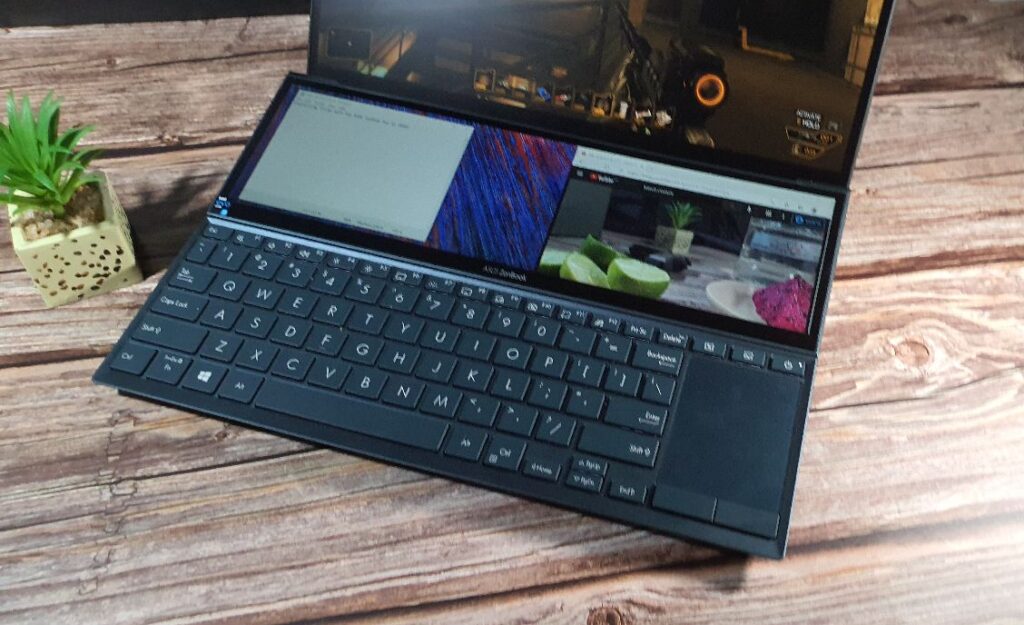
These differences aside, our review sample has the same 11th Gen Intel Core i7-1165G7 2.8GHz processor, the same 13.4-inch-Full HD 60Hz NanoEdge display and identical secondary 12.6-inch 60Hz ScreenPad Plus. A cheaper variant also packs an 11th Gen i6-1135G7 2.4GHz CPU and 8GB RAM.
Both the main display and ScreenPad Plus are touch capable. It also comes with the same array of freebies including an adhesive kickstand, a stylus and a free backpack.
Overall build quality is excellent for a mass produced laptop with an aluminium top lid and polycarbonate underside and keyboard tray. There’s no creaking or play in the top lid and the matte finish repels fingerprints nicely.
ASUS ZenBook Duo UX482 Benchmarks
There’s no direct equivalent that we’ve tested before with a configuration similar to our review unit but the closest parallel would be the Zenbook 14 UX428 EA that we tested a while back which has a similar Intel Core i7-1165G7 processor, Iris Xe graphics but with much less memory at 8GB DDR4 RAM.
Logically, it should have a similar performance envelope but scaled up on account of having four times the amount of RAM.
To obtain the benchmarks we plugged the ASUS ZenBook Duo UX482 through its paces into the mains with settings set on Balance and on Performance mode in the built-in My Asus console.
Of note is that the ZenBook Duo 14 UX482 is also the first ZenBook series laptop in ASUS’s line-up in 2021 to receive their ASUS Intelligent Performance Technology (AIPT) that is actually a set of baked-in firmware that min/maxes the CPU power limit values and fan speed settings to potentially, according to ASUS, achieve up to 40% better performance.
Via AIPT, you’re able to access a Whisper, Balanced and Performance mode to tweak the CPU power limit from 15 to 28W and dial up the fan speed to compensate without having to go into BIOS settings. These settings are accessed via their MyASUS app.
In Performance mode, ASUS claims it can improve CPU performance by 20% versus standard mode and up to 40% versus their previous generation. In their Balanced mode, the laptop balances everything for general duties.
To obtain the benchmarks we plugged the ASUS ZenBook Duo UX482 through its paces into the mains with settings set on Balance and on Performance mode in the built-in My Asus console We got the following benchmarks for both modes.
| Benchmark | Balanced Settings | Performance Settings |
| Unigine Superposition 720P Low | 6,761 | 6775 |
| Unigine Superposition 1080P Medium | 3,200 | 3,248 |
| Unigine Superposition 1080P High | 2,280 | 2332 |
| Unigine Superposition 1080P Extreme | 1,053 | 1,102 |
| 3DMark Fire Strike | 5,032 | 5,304 |
| 3DMark Fire Strike Extreme | 2,290 | 2,538 |
| 3DMark Fire Strike Ultra | 1,278 | 1,338 |
| 3DMark Time Spy | 1,733 | 1,832 |
| 3DMark Time Spy Extreme | 798 | 836 |
| GeekBench 5 Single Core Score | 1,476 | 1,488 |
| GeekBench 5 Multi Core Score | 5,052 | 5,353 |
| Cinebench R20 | 1,783 | 2,057 |
| 3DMark Night Raid | 11,189 | 17,416 |
| PCMark 10 Extended | 4,656 | 4,761 |
ZenBook Duo 14 UX482 Performance
Synthetic benchmarks aside, the new ZenBook Duo 14 UX482 proves to be an immensely capable multitasking ultraportable when tackling practical work scenarios in the field.
In keeping with its Project Evo certification by Intel, the laptop boots up in seconds and has both WiFi 6 connectivity and a pair of Thunderbolt 4 compliant ports, among its many virtues. This will hold true for the Malaysia retail units as well as they are all Project Evo certified.
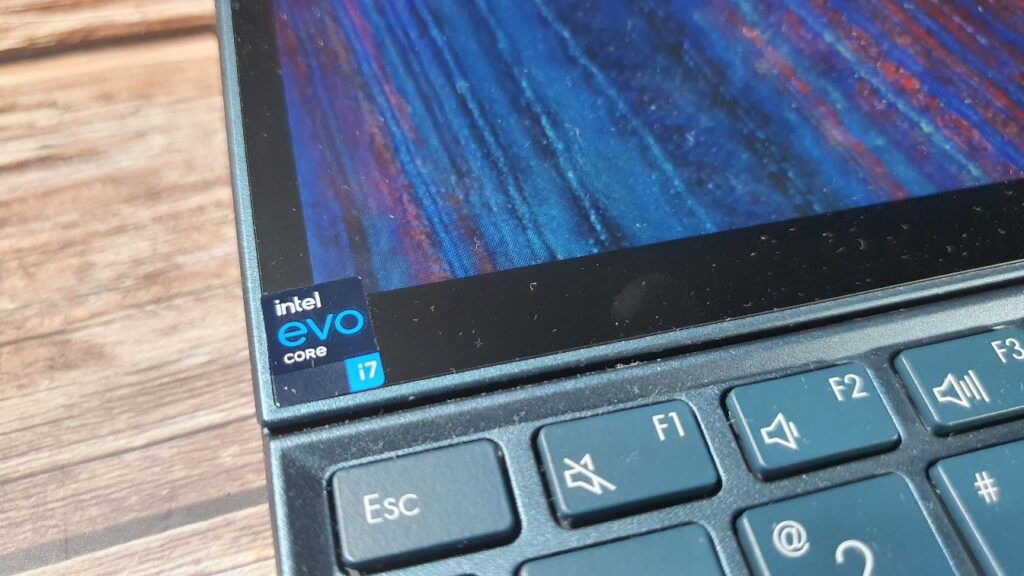
For daily work tasks, our test sample tackled everything thrown at it for work, web browsing and short 4K video editing tasks. It was able to play Far Cry 5 at 1080P at low settings with modestly low frame rates as well as Deus Ex Mankind Divided but alas wasn’t able to run Cyberpunk 2077.
If you’re still dead set on gaming, it works best on last-gen offerings like the aforementioned Far Cry 5 and simpler games like Kingdom New Lands. It’s doubtful that even the MX450 enabled variant will be able to run Cyberpunk 2077 either but this laptop is, in any case, meant for work.
In Performance mode, the laptop was able to deliver slightly better performance by maxing out the processor and Iris Xe graphics though this is at the cost of it being noticeably warmer and with increased fan noise that’s loud enough to hear in a quiet room.
In Balanced mode, you get slightly lower but still viable performance balanced out by cooler thermals and much less fan noise. With web browsing and basic paperwork, it’s almost whisper quiet.

We’ve yet to test any laptop with an NVIDIA GeForce MX450 card and our UX482 sample lacks one so we can’t quite comment on its performance in local Malaysia samples of the ZenBook Duo UX482. The NVIDIA GeForce MX450 is still an entry level card and succeeds the prior MX350 that debuted last year.
The inclusion of a dedicated graphics card would confer better graphics performance for basic gaming and video editing for the Malaysia version of the Duo 14 UX482.
Built on a 12nm process and based on the Turing architecture, the NVIDIA GeForce MX450 graphics card uses the same TU117 chips as the older GeForce GTX1650 but with reduced performance with a 1.58GHz clock speed.
Again, this won’t let you tackle Cyberpunk 2077 by any measure but it’ll handle last gen gaming at low settings. Based on the results of our benchmarks, a stock Malaysia ZenBook Duo 14 UX482 should have better graphics processing performance and the provided 16GB RAM is sufficient for most needs save for heavy 4K video editing or other more demanding tasks.
Display
The provided 14-inch Full HD touchscreen on the ZenBook Duo 14 UX482 has a conventional 16:9 aspect ratio with a 93% screen-to-body ratio along with Pantone validation and 100% sRGB colour gamut.
The secondary ScreenPad Plus is more rectangular with an IPS panel that has 1,920 x 540 pixels, measuring in at 12.6-inches diagonal and a similar 93% screen-to-body ratio as the main display. The secondary panel also has Pantone validation and 100% sRGB colour gamut support.

Of note is that both displays are touch capable, have a 60Hz refresh rate and are rated for 400 nits peak brightness. This means that the UX482’s displays aren’t ideal for gaming but that’s not its intended mission profile anyway.
While both displays are rated to have equal brightness and vibrancy on paper, the ScreenPad Plus visibly doesn’t seem to be able to offer as much brightness and isn’t as vibrant as the main display. It looks slightly dimmer even when cranked up to maximum.
The paired Harman Kardon stereo speakers are surprisingly loud and are more than sufficient for the odd Netflix binge or two and running through your Spotify playlist. Fortunately, the Duo 14 UX482 does retain a top mounted 720p webcam though it’s nothing to write home about with sufficient quality for video calls but you’ll need a ring light for best results.
Ergonomics
In terms of ergonomics, the laptop has minor improvements but still has the same challenges befalling its predecessor. The ScreenPad Plus secondary display makes for a fantastic expansion of screen real estate whether you’re using the extra screen for additional shortcuts in apps or as extra screen space for true multitasking.
Rather than having to install an additional monitor, the ScreenPad Plus does let you do multiple things simultaneously. You can continue working on the main display and still leave a window open for Netflix at the bottom with the ability to drag and drop open tabs and windows between the main panel and ScreenPad Plus as you see fit.
The raised angle and exceptional responsiveness of the ScreenPad Plus makes it fantastic to use with the ability to achieve very precise input; I rarely needed to use the provided stylus except for actual illustration work or annotating documents for later editing.
Needless to say, there are tradeoffs. Shoehorning a 12.5-inch display does have a price to pay and this benefit is at the expense of the keyboard that has been squished into the bottom of the laptop which we’ll get to in a minute.
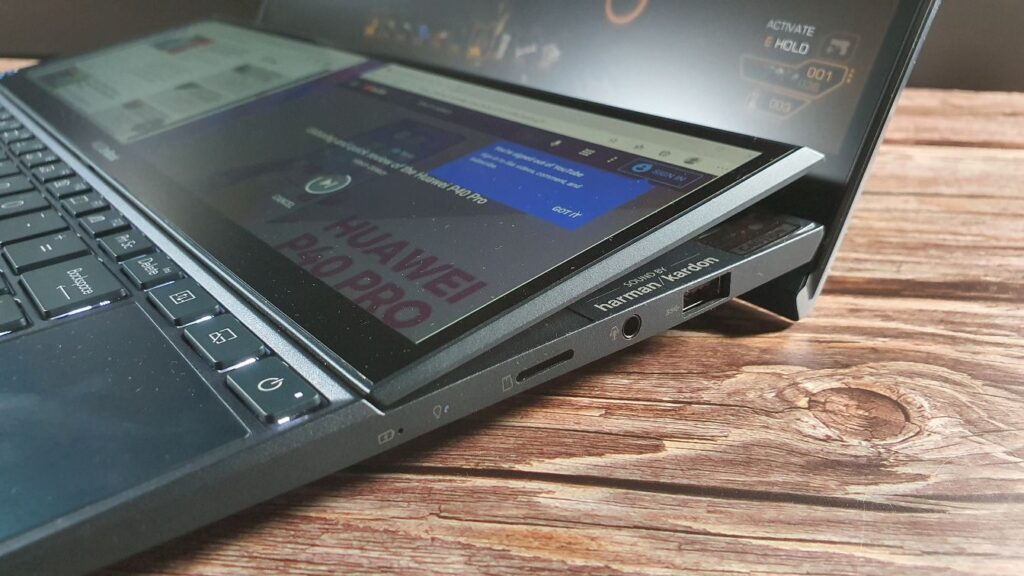
Keyboard
The existing layout has tiny, cramped keys and a miniscule touchpad that’s barely larger than a shipping label while the lack of palm rests and the layout means that it’s not practical to use this on your lap unless you hold your fingers like a pianist and peck at the keys.
Ideally, the ZenBook Duo 14 UX482 works best if you plonk it on a table slightly farther away than you’d normally do for a standard laptop to better access the keyboard and the ScreenPad.
The ergonomics are a fair compromise but credit where it’s due, no other manufacturer has been bold enough to pull a design like this off and be successful enough to offer a second generation version of it. And if you’re stuck on a plane with this, you’ll easily be the best equipped user for work on the entire plane with the most screen real estate.
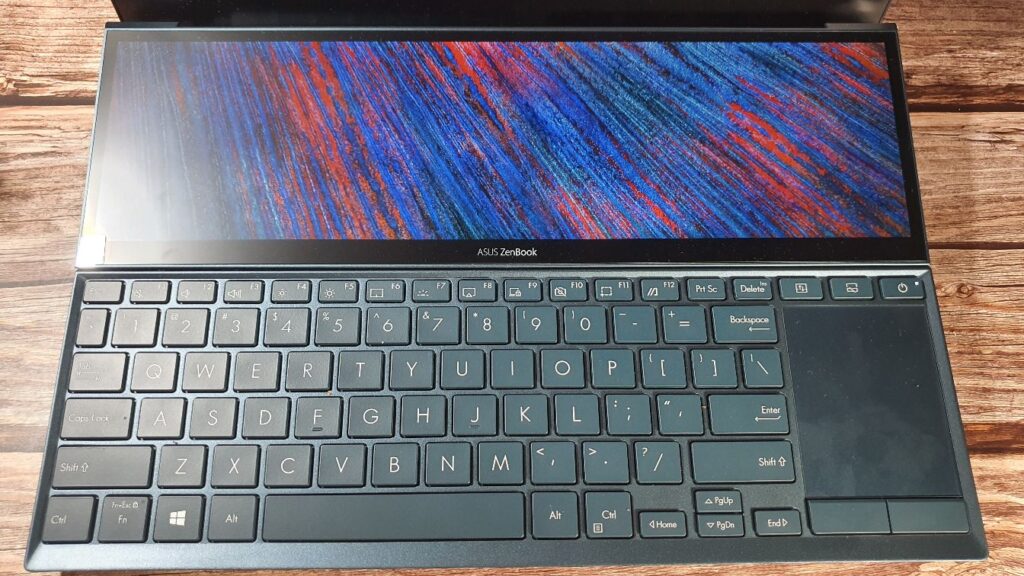
Cramped layout aside, the keyboard’s is fairly comfortable to type on and has good key travel for touch typing once you get used to its squished layout but the tiny touchpad is a miss as it’s so small that there’s not much space to do anything much beyond moving your cursor in short, jerky motions across the screen.
As a portable productivity device, it’s best suited for content creators and artists where the additional displays offer more virtual work space. This also proves useful for spreadsheet jockeys as you’re able to take in more of a workspace in one glance while leaving room for other applications.
If you’re primarily a writer or someone who works with text more than videos or images, the keyboard will unfortunately cramp your style and Asus’s other ZenBooks with fuller sized keyboards will be a better proposition.
Battery Life
The ZenBook Duo 14 UX482 packs a 70Wh 4-cell lithium ion battery and Intel Evo certification which bodes well for its rated endurance time. With the ScreenPad Plus on, with WiFi and a modest workload of light video editing, web browsing and a video running on Youtube in a tabbed corner, the laptop was able to last 10 hours and 5 minutes which is more than enough to power through the average working day.
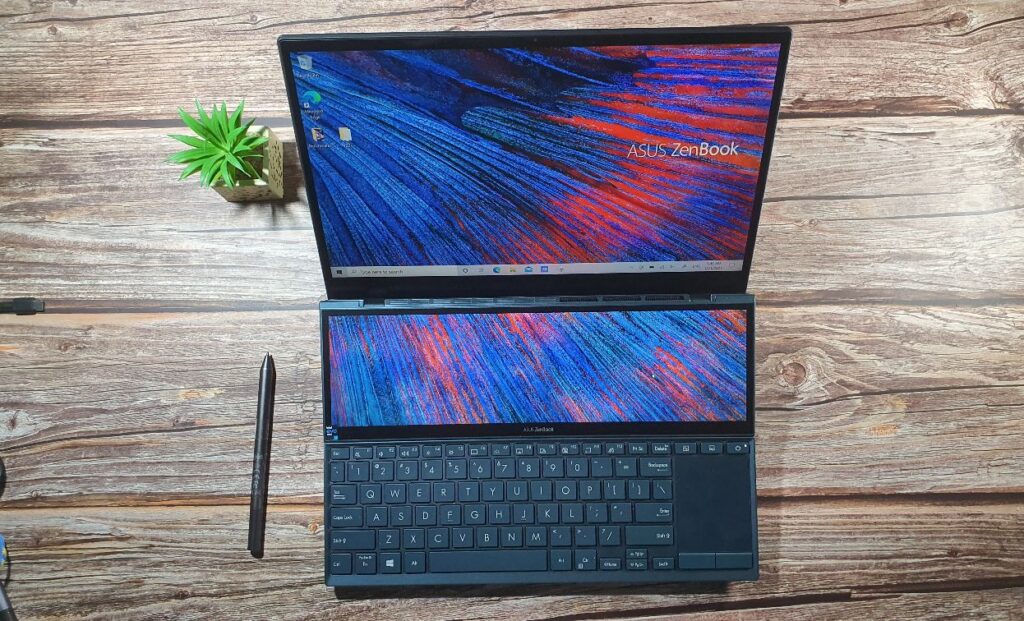
If you disable the secondary ScreenPad Plus, which somewhat defeats the original purpose of the ZenBook Duo 14 UX482, you’ll eke out a bit more juice at just over 13 hours of battery life which means you’re adding an additional 3 hours or so of usage. Fortunately, its charging brick is a compact affair so it makes it relatively easy to charge in the field.
Is the ASUS ZenBook Duo 14 UX482 worth buying?
Our version of the ASUS ZenBook Duo 14 UX482 is an immensely capable ultraportable with plenty of pixel crunching grunt and sufficient performance for almost most content creation duties short of heavy video editing and gaming.
Building on this impressive base, the local Malaysia version of the ZenBook Duo 14 UX482 is an even more capable beast on account of its NVIDIA MX450 graphics and its 16GB RAM is sufficient for most tasks. The cheaper version with 8GB RAM, an 11th Gen i5 CPU and an MX450 GPU is also available but it’s best suited as a more basic, versatile content creation rig for daily computing and photo editing tasks.
Regardless, the ASUS ZenBook Duo 14 UX482 is a powerful, highly capable laptop with a unique secondary touchscreen that offers truly immense capabilities and multitasking versatility.
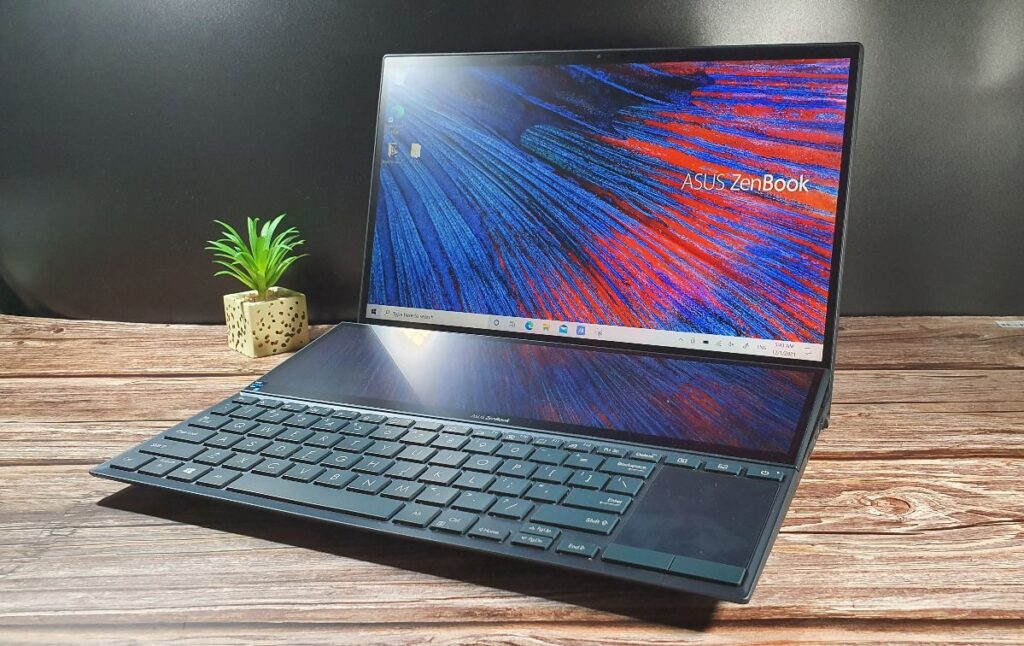
Unfortunately, regardless of version, the cramped nature of its keyboard and touchpad remains its biggest Achilles heel which makes it less than ideal if you need to write a lot of text. If you require a laptop with exceptional endurance that is ideal for content creators and heavy multitaskers, the ZenBook Duo UX482 is a unique proposition that ought to be tops on your wish list.
Once we get our hands on an UX482 with a local configuration, we’ll be sure to test it but in the meantime, our review unit of the ZenBook 14 UX482 deservedly deserves a shiny gold award for its innovative features and performance.

Review unit courtesy of ASUS Malaysia. For more details on the ZenBook Duo 14 UX482, visit their official page here.
ASUS ZenBook Duo 14 UX482
-
Display
-
Performance
-
Battery Life
-
Design
-
Value
ASUS ZenBook Duo 14 UX482
The ASUS ZenBook Duo 14 UX482 is a powerful, highly capable laptop with a unique secondary touchscreen that offers immense multitasking capabilities . Unfortunately, the cramped nature of its keyboard and touchpad remains its biggest Achilles heel which makes it less than ideal if you need to write a lot of text. If you require a laptop with exceptional endurance that is ideal for content creators and heavy multitaskers, the ZenBook Duo UX482 is a unique proposition that ought to be tops on your wishlist.
Pros
Excellent primary and ScreenPad Plus touchscreen displays
Good performance
Innovative design
Lots of free accessories
Improved ScreenPad Plus functionality
Cons
Cramped keyboard layout
Tiny touchpad
Non-upgradable RAM

0 Comments